What is Raw Indian Hair?
Raw Indian hair is unprocessed, natural hair that has been collected from donors in India. It is considered to be the highest quality hair available on the market, as it has not been subjected to any chemical treatments or dyes. This means that it is soft, silky, and free of tangles and shedding.

2 Key Benefits of Raw Indian Hair:
- Unprocessed and natural, ensuring its premium quality
- Versatile and can be styled in various ways to suit your preferences
Why Choose Raw Indian Hair?
There are many benefits to choosing raw Indian hair over other types of hair extensions. These benefits include:
- Longevity: Raw Indian hair can last for up to two years with proper care, making it a worthwhile investment.
- Durability: This hair type is resistant to heat and damage, allowing for versatile styling without compromising its integrity.
- Natural Appearance: Its unprocessed nature ensures a seamless blend with your natural hair, providing a natural-looking result.
- Comfort: Raw Indian hair is lightweight and comfortable to wear, allowing you to enjoy your new locks without any discomfort.
5 Tips for Caring for Raw Indian Hair
To ensure the longevity and quality of your raw Indian hair, follow these care tips:
- Wash your hair less frequently, ideally every 2-3 weeks.
- Use sulfate-free shampoos and conditioners to avoid stripping natural oils.
- Avoid using heat styling tools excessively.
- Deep condition your hair regularly to maintain its moisture and shine.
- Protect your hair from chlorine and salt water by wearing a swimming cap or rinsing thoroughly after exposure.
How to Style Raw Indian Hair
Raw Indian hair can be styled in various ways to suit your personal preferences. Here are a few popular styling options:
- Natural: Embrace the natural texture of your hair and let it air dry for a effortless, no-fuss look.
- Sleek and Straight: Use a flat iron to achieve a sleek, polished finish that adds sophistication to any outfit.
- Curly: Utilize a curling iron or wand to create bouncy, voluminous curls that exude glamour and fun.
- Braids: Experiment with different braiding techniques to add texture and interest to your hairstyle.
- Updos: Gather your hair into elegant updos, such as buns, chignons, or ponytails, for formal events or special occasions.
4 Popular Questions About Raw Indian Hair
1. How long does raw Indian hair last?
With proper care, raw Indian hair can last for up to two years.
2. Can raw Indian hair be dyed or bleached?
Yes, but it is recommended to consult a professional hairstylist to avoid damaging the hair.
3. Is raw Indian hair suitable for all hair types?
Yes, raw Indian hair is versatile and can be matched to various hair textures, making it suitable for all hair types.
4. How often should I wash raw Indian hair?
Wash your raw Indian hair less frequently, ideally every 2-3 weeks, to maintain its natural oils and prevent dryness.
Table 1: Comparison of Raw Indian Hair with Other Hair Types
| Hair Type | Key Features | Pros | Cons |
|---|---|---|---|
| Raw Indian Hair | Unprocessed, natural, durable | Longevity, versatility, natural appearance | Higher cost |
| Virgin Hair | Unprocessed, but may have undergone minimal chemical treatments | Good quality, affordable | May not be as durable as raw hair |
| Remy Hair | Cuticles aligned in the same direction | Smooth, tangle-free | Can be more expensive than raw hair |
| Synthetic Hair | Made from artificial fibers | Affordable, low maintenance | Unnatural appearance, not heat-resistant |
Table 2: Benefits of Raw Indian Hair for Different Occasions
| Occasion | Benefits |
|---|---|
| Everyday Wear | Natural appearance, comfortable to wear |
| Formal Events | Versatile styling options, adds sophistication |
| Weddings | Creates stunning braids, updos, and other elegant hairstyles |
| Vacations | Heat-resistant, protects hair from sun and salt water |
| Sports and Activities | Lightweight and secure, allows for active movement |
Table 3: Tips and Tricks for Styling Raw Indian Hair
| Tip | Benefit |
|---|---|
| Use a wide-tooth comb | Prevents breakage and tangles |
| Apply a leave-in conditioner | Provides moisture and protection |
| Braid your hair before bed | Reduces frizz and tangles |
| Use a heat protectant spray | Protects hair from heat damage |
| Trim split ends regularly | Maintains healthy hair and prevents further damage |
Table 4: Pros and Cons of Raw Indian Hair
| Pros | Cons |
|---|---|
| 100% natural and unprocessed | More expensive than other hair types |
| Durable and long-lasting | Requires more maintenance than synthetic hair |
| Versatile and can be styled in various ways | Not as heat-resistant as synthetic hair |
| Healthy and gentle on your scalp | May shed more than other hair types |
Customer Testimonials
“I’ve been using raw Indian hair for years and I absolutely love it! It’s so soft, silky, and natural-looking. I get compliments on my hair all the time.” – Sarah J.
“I was hesitant to try raw Indian hair at first because of the price, but I’m so glad I did. It’s completely transformed my look and given me so much more confidence.” – Emily K.
“I’ve tried many different types of hair extensions, but raw Indian hair is by far the best. It blends seamlessly with my natural hair and it lasts for so long.” – Jessica L.
Conclusion
If you’re looking for the highest quality hair extensions that will give you a natural and luxurious look, then raw Indian hair is the perfect choice for you. Its unprocessed nature, durability, and versatility make it an investment that will last. Embrace the beauty of raw Indian hair and elevate your style to new heights.
